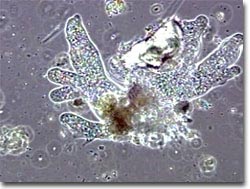

Eukaryotes share anatomical similarities which make their information transfer pathways more complex as well as faster than those of prokaryotes. The processes whereby materials (e.g. nutrients) and information are diffused within a eukaryotic cell are more complex than those in a prokaryotic cell, simply because eukaryotic cells are so much bigger (Kaiser, 2001; Illingworth, 1999; Cotterill, 2001, p. 5). Because a prokaryotic cell is so small, it has a large surface-to-volume ratio, so nutrients can rapidly reach any part of the cell's interior. Eukaryotic cells, being much larger, have a smaller surface-to-volume ratio, so nutrients cannot rapidly spread to all internal parts of the cell. For this reason, eukaryotic cells require a variety of specialised structures to carry out metabolism, provide energy, and transport chemicals throughout the cell.
Additionally, all eukaryotes (protoctista, plants, fungi and animals) make use of rapid electrochemical signalling to transmit information, in addition to the slow process of chemical diffusion used by bacteria. Eukaryotic cells are much larger than bacterial cells, so they are able to detect tiny spatial concentration gradients from one side of the cell to another when searching for food, instead of relying on measurements taken at successive 3-second intervals as bacteria do. Unlike bacteria, eukaryotes know which way to swim, but they use larger motors and a different internal signalling system. For example, electrochemical signalling (resulting from the interaction of proteins with calcium ions and the energy-storing molecule ATP) enables protozoa to move around.
Back to Protoctista References *** SUMMARY of Conclusions reached